Abstract
The metabolism of human plasminogen labeled with radioactive iodine was studied in 12 healthy men. The labeled plasminogen had a high specific activity and the same elution on Sephadex G-100 as the plasminogen activity in plasma. Immunoelectrophoresis revealed a single precipitin line. Polyacrylamide gel electrophoresis revealed six main bands, all with plasminogen properties and radioactivity. The purified plasminogen behaved as a homogeneous protein in the turnover experiments. The plasma radioactivity data were adequately approximated by a sum of two exponential terms. The metabolism of plasminogen was therefore represented by a two-compartment mammillary model.
Results in the 12 normal subjects were as follows: plasma plasminogen concentration 20.8±1.9 mg/100 ml; intravascular plasminogen pool 0.66±0.14 g; intravascular fraction 0.59±0.06; fractional catabolic rate 0.55±0.09 of the plasma pool per day; half-life of the plasma radioactivity 2.21±0.29 days. Circulating large-molecular-weight degradation products of labeled plasminogen could not be detected by Sephadex G-100 gel filtration.
The plasminogen turnover rate was normal in a patient with Behçet's syndrome and low circulating plasminogen activator activity. This finding supports the concept that under normal conditions the primary pathway of plasminogen catabolism is not via the formation of plasmin.
The in vivo effect of tranexamic acid, a potent inhibitor of plasminogen activation, on the turnover of labeled plasminogen was studied in five normal subjects. When 1 g was administered perorally t.i.d. to three of them, one showed an increased plasminogen turnover. A 2 g dose administered t.i.d. to the other two caused markedly increased catabolism in both. This increase may be attributable to a direct reversible effect of tranexamic acid on the plasminogen molecule.
Full text
PDF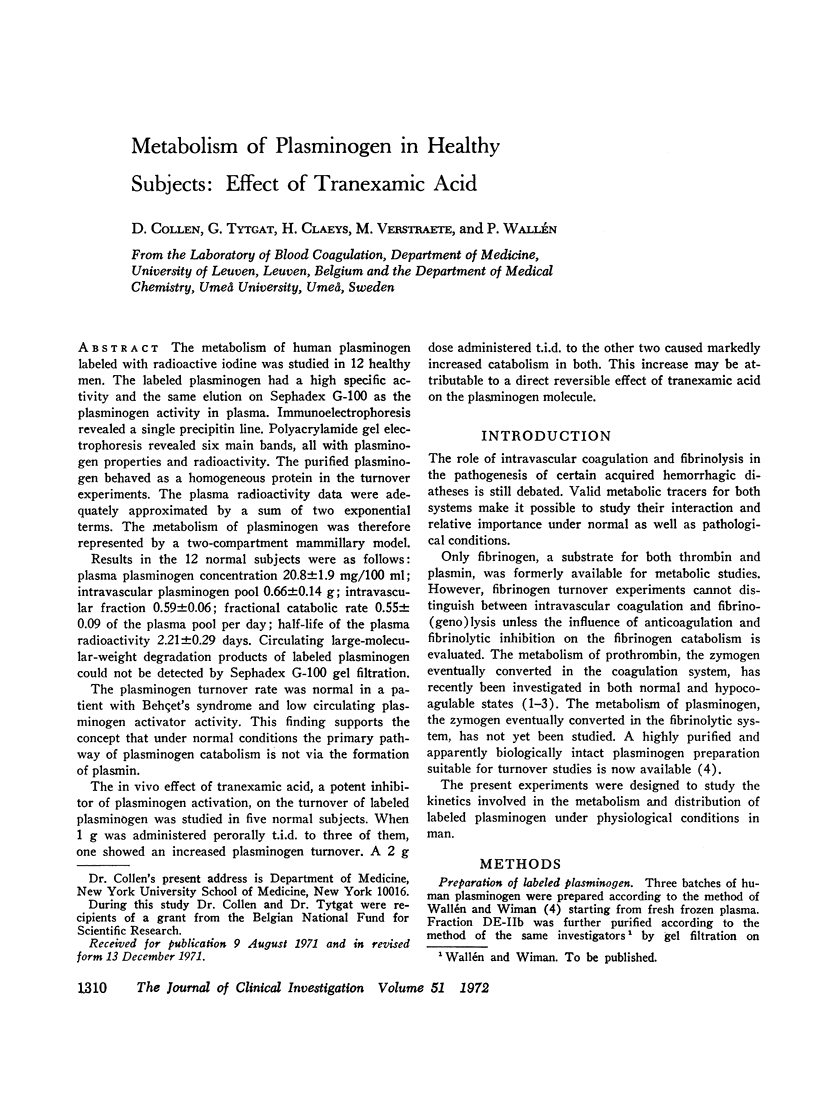
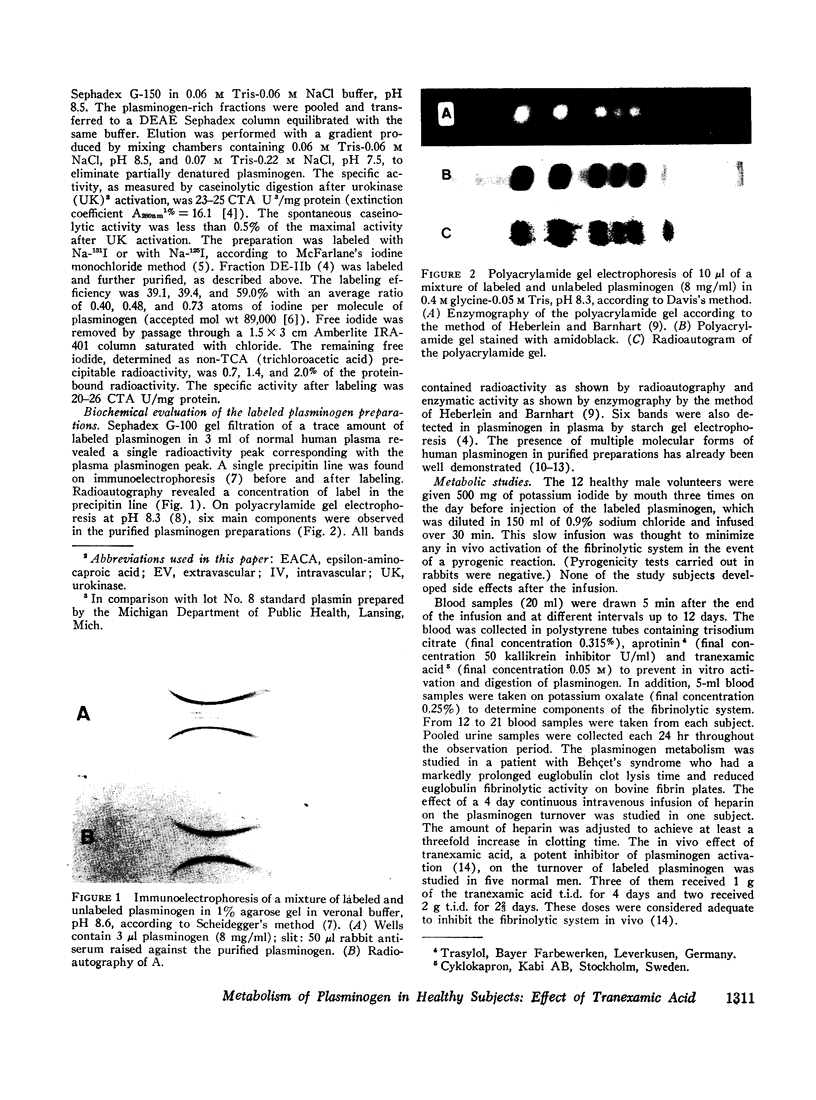
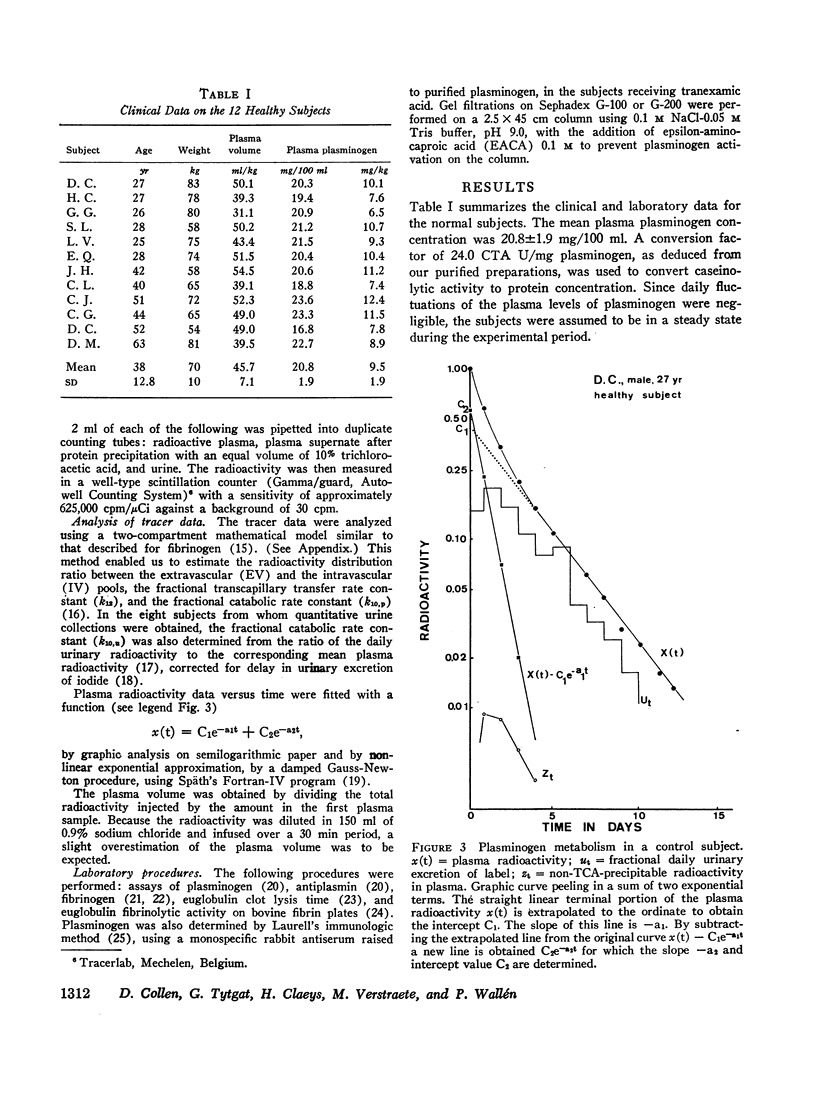

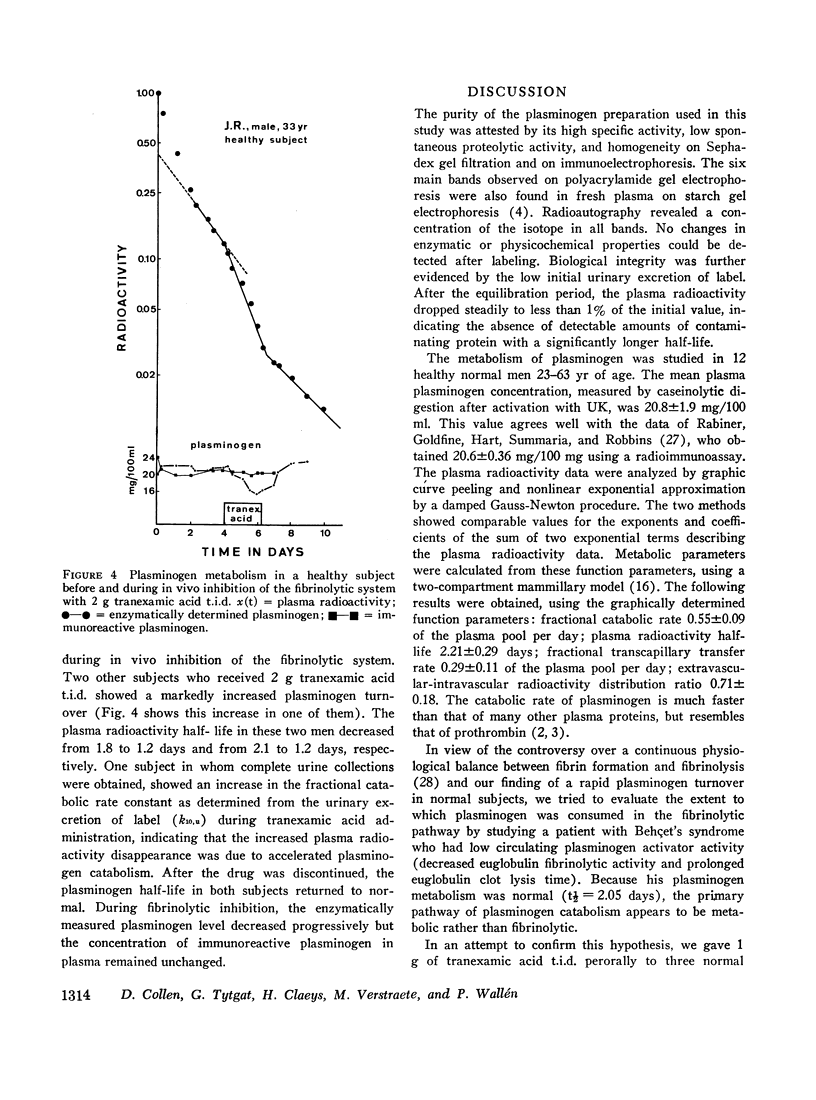
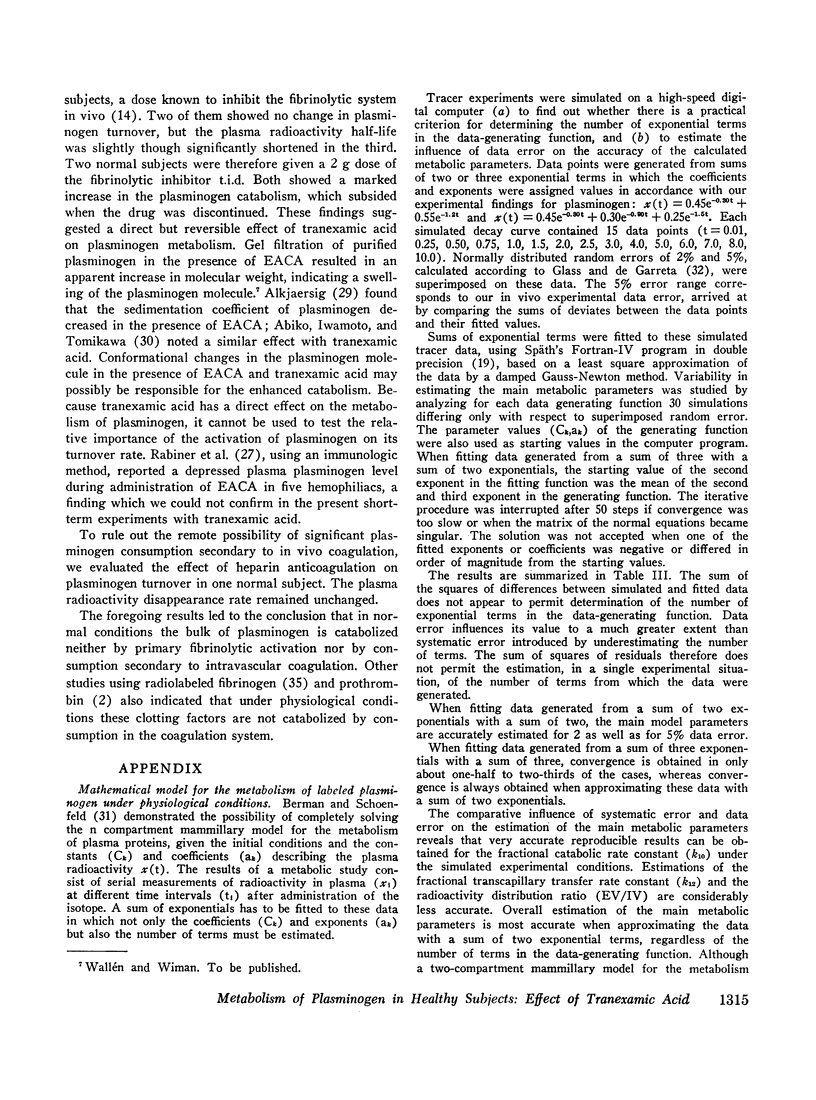

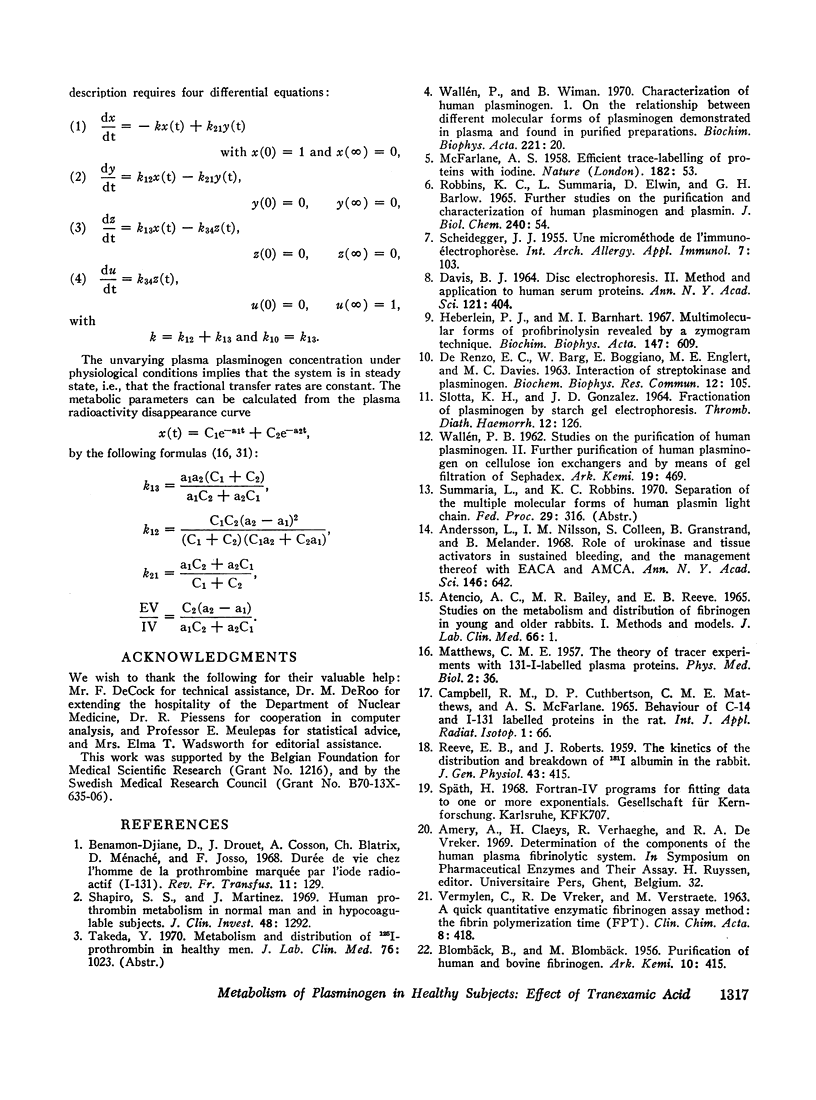
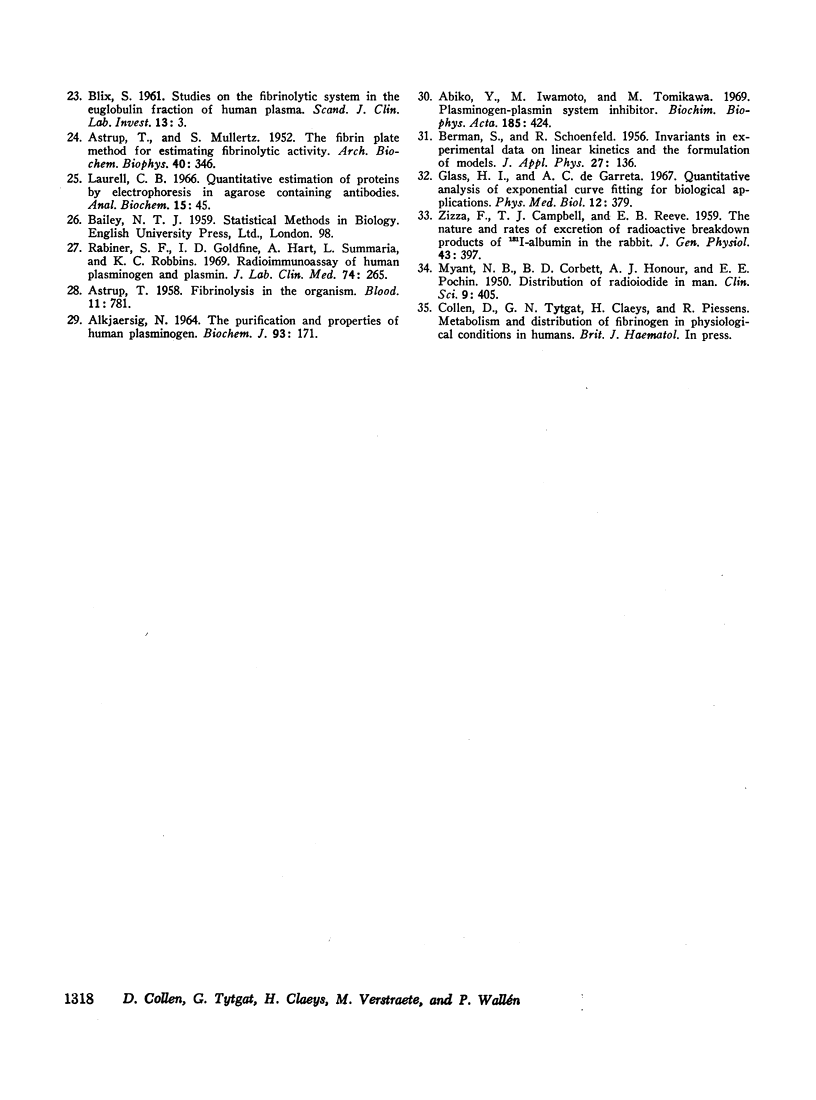
Images in this article
Selected References
These references are in PubMed. This may not be the complete list of references from this article.
- ASTRUP T. Fibrinolysis in the organism. Blood. 1956 Sep;11(9):781–806. [PubMed] [Google Scholar]
- ASTRUP T., MULLERTZ S. The fibrin plate method for estimating fibrinolytic activity. Arch Biochem Biophys. 1952 Oct;40(2):346–351. doi: 10.1016/0003-9861(52)90121-5. [DOI] [PubMed] [Google Scholar]
- Abiko Y., Iwamoto M., Tomikawa M. Plasminogen-plasmin system. V. A stoichiometric equilibrium complex of plasminogen and a synthetic inhibitor. Biochim Biophys Acta. 1969;185(2):424–431. doi: 10.1016/0005-2744(69)90435-5. [DOI] [PubMed] [Google Scholar]
- Alkjaersig N. The purification and properties of human plasminogen. Biochem J. 1964 Oct;93(1):171–182. doi: 10.1042/bj0930171. [DOI] [PMC free article] [PubMed] [Google Scholar]
- Andersson L., Nilsoon I. M., Colleen S., Granstrand B., Melander B. Role of urokinase and tissue activator in sustaining bleeding and the management thereof with EACA and AMCA. Ann N Y Acad Sci. 1968 Jun 28;146(2):642–658. doi: 10.1111/j.1749-6632.1968.tb20322.x. [DOI] [PubMed] [Google Scholar]
- BLIX S. Studies on the fibrinolytic system in the euglobulin fraction of human plasma. A. Methodological study. B. Application of the methods. Scand J Clin Lab Invest. 1961;13 (Suppl 58):3–19. [PubMed] [Google Scholar]
- Benamon-Djiane D., Drouet J., Cosson A., Blatrix C., Ménaché D., Josso F. Durée de vie chez l'homme de la prothrombine marquée par l'iode radioactif (131-I) Rev Fr Transfus. 1968 Jul;11(2):129–138. doi: 10.1016/s0035-2977(68)80042-2. [DOI] [PubMed] [Google Scholar]
- DAVIS B. J. DISC ELECTROPHORESIS. II. METHOD AND APPLICATION TO HUMAN SERUM PROTEINS. Ann N Y Acad Sci. 1964 Dec 28;121:404–427. doi: 10.1111/j.1749-6632.1964.tb14213.x. [DOI] [PubMed] [Google Scholar]
- DE RENZO E. C., BARG W., Jr, BOGGIANO E., ENGLERT M. E., DAVIES M. C. Interaction of streptokinase and plasminogen; demonstration of a reaction product by ultracentrifugation and starch-gel electrophoresis. Biochem Biophys Res Commun. 1963 Jul 18;12:105–110. doi: 10.1016/0006-291x(63)90243-2. [DOI] [PubMed] [Google Scholar]
- Heberlein P. J., Barnhart M. I. Multimolecular forms of profibrinolysin revealed by a zymogram technique. Biochim Biophys Acta. 1967 Dec 12;147(3):609–612. doi: 10.1016/0005-2795(67)90026-8. [DOI] [PubMed] [Google Scholar]
- Laurell C. B. Quantitative estimation of proteins by electrophoresis in agarose gel containing antibodies. Anal Biochem. 1966 Apr;15(1):45–52. doi: 10.1016/0003-2697(66)90246-6. [DOI] [PubMed] [Google Scholar]
- REEVE E. B., ROBERTS J. E. The kinetics of the distribution and breakdown of 1131-albumin in the rabbit. Observations on several mathematical descriptions. J Gen Physiol. 1959 Nov;43:415–444. doi: 10.1085/jgp.43.2.415. [DOI] [PMC free article] [PubMed] [Google Scholar]
- Rabiner S. F., Goldfine I. D., Hart A., Summaria L., Robbins K. C. Radioimmunoassay of human plasminogen and plasmin. J Lab Clin Med. 1969 Aug;74(2):265–273. [PubMed] [Google Scholar]
- SCHEIDEGGER J. J. Une micro-méthode de l'immuno-electrophorèse. Int Arch Allergy Appl Immunol. 1955;7(2):103–110. [PubMed] [Google Scholar]
- SLOTTA K. H., GONZALEZ J. D. FRACTIONATION OF PLASMINOGEN BY STARCH GEL ELECTROPHORESIS. Thromb Diath Haemorrh. 1964 Oct 15;12:126–136. [PubMed] [Google Scholar]
- VERMYLEN C., DE VREKER R. A., VERSTRAETE M. A rapid enzymatic method for assay of fibrinogen fibrin polymerization time (FPT test). Clin Chim Acta. 1963 May;8:418–424. doi: 10.1016/0009-8981(63)90080-9. [DOI] [PubMed] [Google Scholar]
- ZIZZA F., CAMPBELL T. J., REEVE E. B. The nature and rates of excretion of radioactive breakdown products of I131-albumin in the rabbit. J Gen Physiol. 1959 Nov;43:397–413. doi: 10.1085/jgp.43.2.397. [DOI] [PMC free article] [PubMed] [Google Scholar]




